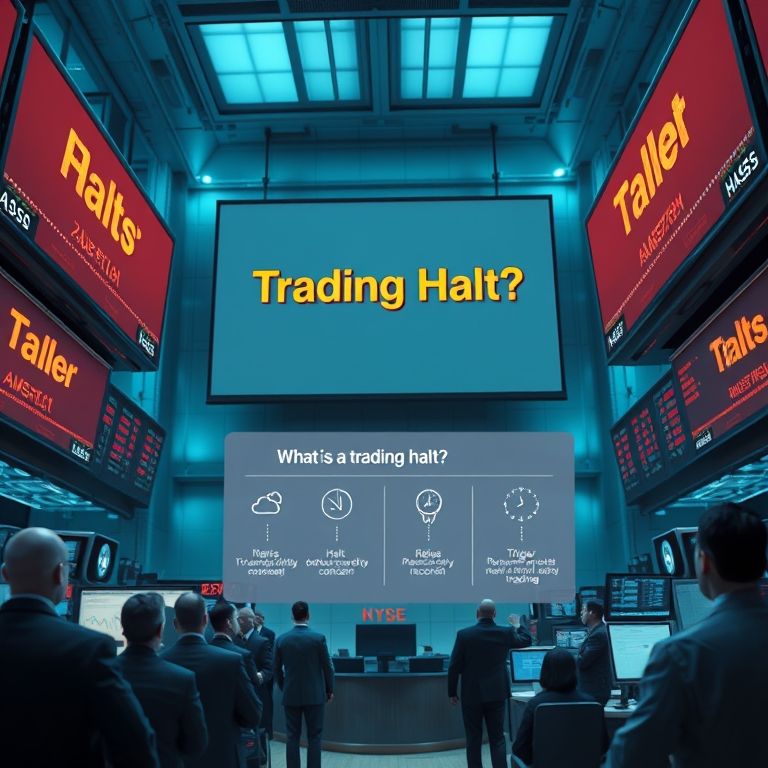what is a trading halt
What is a Trading Halt? The Pause That Keeps Markets Honest
If you’ve ever watched a screen go blank in the middle of a busy trading day, you’ve felt the effect of a trading halt—an official pause designed to protect investors and preserve orderly price discovery. It’s not a glitch or a glitchy feature; it’s a deliberate safeguard that gives everyone a fair chance to catch up when news breaks, liquidity dries up, or volatility spikes beyond the normal range. In a fast-moving market, that pause can be the difference between a rushed mistake and a rational decision.

Traders often learn the hard way that halts aren’t punishment—they’re a signal. A halt on a stock means the venue is slowing the clock to digest information, verify trades, or let liquidity come back into balance. On futures and options, you’ll hear about circuit breakers or price bands that trigger automatic pauses to prevent a panic squeeze. And in the wild west of crypto, where markets run 24/7 and nobody sleeps, halts are rarer and usually come from the exchange’s own risk controls or maintenance windows rather than a centralized regulator.
Triggers and mechanisms
- News-driven halts: A company announces earnings, a merger, or an unexpected development; the exchange stops trading to ensure everyone has access to the same information at the same time.
- Price- and liquidity-based halts: Sharp moves, severely imbalanced buys/sells, or system issues can trigger a pause to stabilize trading.
- Market-wide safeguards: Circuit breakers and limit-up/limit-down rules prevent extreme gaps from cascading across related assets.
- Maintenance and risk controls: Exchanges may pause to perform system upgrades or to cool risk when liquidity evaporates.
What happens during a halt
- Trading stops across bids, asks, and executions; you can’t place or cancel orders that would trade during the halt.
- Quotes may still appear, but execution is suspended until the pause ends.
- When trading resumes, there’s often an opening auction or price rebalance, and volatility can spike briefly as participants react.
Asset classes and implications
- Stocks: Halts are common around earnings, regulatory news, or extraordinary events. They emphasize that price discovery requires time and verified information.
- Options and futures: Halts can occur around big contract expiries or major market moves. Expect widened spreads as liquidity returns.
- Forex: Individual currency pairs aren’t halted on a central exchange the way stocks are; liquidity can dry up in extreme events, but the market tends to remain open globally.
- Indices and commodities: Indices reflect the underlying baskets; halts on component names can ripple to the index. Commodities may halt due to supply disruptions or exchange risk controls.
- Crypto: Expect central exchange–driven suspensions for maintenance or security concerns; 24/7 trading complicates the idea of a “halt,” but individual venues still pause when needed.
Practical trading strategies and risk management
- Plan for gaps: Have a pre-set rule for where you’ll re-enter after a halt; avoid chasing a swing that’s already moved.
- Manage leverage carefully: Halts can widen spreads and cause rapid price moves once resumed; lower leverage around known news events.
- Use multi-venue checks: If you rely on a single feed, you may miss the other side of the halt; corroborate with alternate data sources and alerts.
- Build in time buffers: Don’t rely on instant executions around announcements; give your orders time to queue once markets reopen.
- Chart with context: After a halt, look at pre-halt and post-reopen prices to gauge whether you want to participate in the new range or wait for further clarity.
Reliability and tools for modern traders
- Data feeds and alerts: Redundant data sources, price alerts, and alerted news feeds help you act calmly when halts occur.
- Charting and risk dashboards: Real-time risk metrics, stop placements, and volatility overlays help you adjust on the fly.
- Risk controls: Auto-stop, max daily loss, and position-size limits keep you from overreacting during the pause-and-reopen cycle.
DeFi, centralization, and the road ahead
- Centralized finance still governs most halt mechanics; exchanges can pause, which protects retail traders but concentrates risk in a few venues.
- Decentralized finance challenges: No single “halt button” for the entire market; on-chain systems can’t easily pause global activity, which raises concerns during flash crashes or cross-chain liquidity crunches.
- Reliability questions: How do you safeguard funds and trades if a protocol or bridge goes offline during a halt-like event?
Future trends: smart contracts, AI, and new horizons
- Smart contract halts and guardrails: On-chain rules could trigger automatic pauses when risk metrics cross thresholds, then resume once governance approves or risk subsides.
- AI-driven risk monitoring: Machines can detect unusual patterns earlier, advising traders when to reduce exposure before a halt hits.
- Cross-asset and tokenized markets: The next wave lands with integrated risk controls across stocks, forex, crypto, and commodities, making cross-asset halts or automatic re-pricing more feasible.
- Education and accessibility: As halts become part of more mainstream platforms, traders gain clearer playbooks and safer leverage options.
A slogan to remember
Trading halt: the pause that protects your playbook, giving you time to plan, verify, and execute with confidence.
Real-life takeaway
I’ve been there—watching a position flutter toward a risk level, then hearing the halt bell ring. The moment can feel frustrating, but it buys time to reassess, read the news, and avoid a knee-jerk decision. With the right tools, risk rules, and a calm mindset, halts become a strategic feature rather than a hurdle. Whether you’re trading stocks, forex, crypto, or futures, understanding how and why halts happen helps you navigate the modern markets with steadier hands and smarter bets.